Xiaomi, the Chinese tech giant, has been a dominant player in the Indian smartphone market for many years. However, in recent times, the company has faced stiff competition from rivals like Samsung, Vivo and OnePlus, especially in the mid-range and premium segments. To regain its lost market share and customer preference, Xiaomi has embarked on a journey of premiumisation, offering high-end features and performance at competitive prices.
Xiaomi Premiumisation Strategy
Xiaomi India president Muralikrishnan B, in an interview with Hindustan Times , revealed that the company decided to execute a “reset, refresh and recharge” strategy in 2023, after realizing that some things had not gone as planned. He said that the company focused on a “clearer and cleaner” portfolio, offline retail channel growth, 5G adoption and strengthening the user experience.
One of the key aspects of this strategy was to launch premium smartphones under the Redmi brand, which is traditionally known for its budget offerings. The Redmi Note 13 series, which was launched in February 2024, was a prime example of this. The series consisted of three models: Redmi Note 13 (starting from ₹ 17,999), Redmi Note 13 Pro (starting from ₹ 25,999) and Redmi Note 13 Pro+ (starting from ₹ 31,999). The latter two models offered features like 120Hz AMOLED displays, Snapdragon 888 processors, 108MP cameras and 67W fast charging, competing with the likes of OnePlus 11R and Nothing Phone (2).
Muralikrishnan claimed that the Redmi Note 13 series had generated ₹ 2,000 crores worth of revenue in its first month of sales, although he did not disclose the exact sales numbers or the share between the three models. He also said that the company had sold 3 million units of the Redmi 12 5G, which was launched in August 2023 as India’s most affordable 5G phone at the time (priced around ₹ 13,000).
“I believe all the efforts we have taken in building traction with the offline retail channels, and the foundation has been laid to deliver to the premiumisation journey,” Muralikrishnan said.
Xiaomi Offline Retail Expansion
Another important aspect of Xiaomi’s strategy was to expand its presence in the offline retail channels, which account for a large chunk of smartphone sales in India. Muralikrishnan said that the company had increased its offline retail partners from 10,000 to 25,000 in the last year, covering over 850 cities across India. He also said that the company had revamped its own Mi Home stores to showcase its premium devices better.
“We have also introduced new formats like Mi Studio and Mi Store on Wheels to cater to different consumer segments and geographies,” he added.
Muralikrishnan also said that Xiaomi was working closely with its offline retail partners to offer attractive schemes and offers to customers, such as no-cost EMIs, cashbacks and exchange programs.
Software Synergy
The third pillar of Xiaomi’s strategy was to enhance its software offerings and create synergy between its different product lines. Muralikrishnan said that Xiaomi had invested heavily in developing its own operating system, HyperOS, which powers its smartphones, tablets, laptops and smart TVs. He said that HyperOS was designed to offer a seamless and consistent user experience across devices, as well as enable cross-device connectivity and collaboration.
“We have also integrated our Mi Home app with HyperOS, which allows users to control and manage all their IoT devices from one place,” he said.
Muralikrishnan also said that Xiaomi was committed to providing regular software updates and security patches to its devices, as well as listening to user feedback and suggestions.
“We have a very active community of Mi Fans who constantly share their ideas and opinions with us. We also have a dedicated team of engineers who work on implementing these suggestions and improving our products,” he said.
Conclusion
Xiaomi India president Muralikrishnan B expressed confidence that the company’s premiumisation journey would persist and pay off in the long run. He said that the company had learned from its mistakes and challenges in the past and was now focused on delivering quality products and services to its customers.
“We are not chasing market share or volume numbers anymore. We are more interested in being the preferred choice of customers and creating value for them,” he said.
Recent Blog : Paytm and Axis Bank to UPI Third-Party Route
